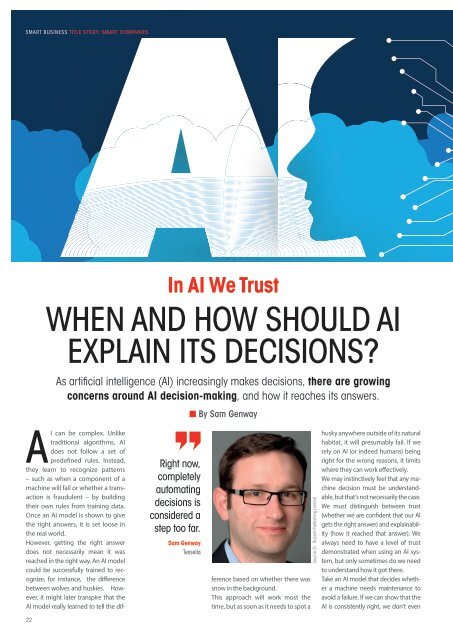Smart Industry 1/2020
Smart Industry 1/2020 - The IoT Business Magazine - powered by Avnet Silica
Smart Industry 1/2020 - The IoT Business Magazine - powered by Avnet Silica
- No tags were found...
You also want an ePaper? Increase the reach of your titles
YUMPU automatically turns print PDFs into web optimized ePapers that Google loves.
<strong>Smart</strong> Business Title Story: <strong>Smart</strong> Companies<br />
In AI We Trust<br />
When and How Should AI<br />
explain ITS Decisions?<br />
As artificial intelligence (AI) increasingly makes decisions, there are growing<br />
concerns around AI decision-making, and how it reaches its answers.<br />
n By Sam Genway<br />
AI can be complex. Unlike<br />
traditional algorithms, AI<br />
does not follow a set of<br />
predefined rules. Instead,<br />
they learn to recognize patterns<br />
– such as when a component of a<br />
machine will fail or whether a transaction<br />
is fraudulent – by building<br />
their own rules from training data.<br />
Once an AI model is shown to give<br />
the right answers, it is set loose in<br />
the real world.<br />
However, getting the right answer<br />
does not necessarily mean it was<br />
reached in the right way. An AI model<br />
could be successfully trained to recognize,<br />
for instance, the difference<br />
between wolves and huskies. However,<br />
it might later transpire that the<br />
AI model really learned to tell the dif-<br />
22<br />
Right now,<br />
completely<br />
automating<br />
decisions is<br />
considered a<br />
step too far.<br />
Sam Genway<br />
Tessella<br />
ference based on whether there was<br />
snow in the background.<br />
This approach will work most the<br />
time, but as soon as it needs to spot a<br />
source ©: Russell Publishing Limited<br />
husky anywhere outside of its natural<br />
habitat, it will presumably fail. If we<br />
rely on AI (or indeed humans) being<br />
right for the wrong reasons, it limits<br />
where they can work effectively.<br />
We may instinctively feel that any machine<br />
decision must be understandable,<br />
but that’s not necessarily the case.<br />
We must distinguish between trust<br />
(whether we are confident that our AI<br />
gets the right answer) and explainability<br />
(how it reached that answer). We<br />
always need to have a level of trust<br />
demonstrated when using an AI system,<br />
but only sometimes do we need<br />
to understand how it got there.<br />
Take an AI model that decides whether<br />
a machine needs maintenance to<br />
avoid a failure. If we can show that the<br />
AI is consistently right, we don’t even
















